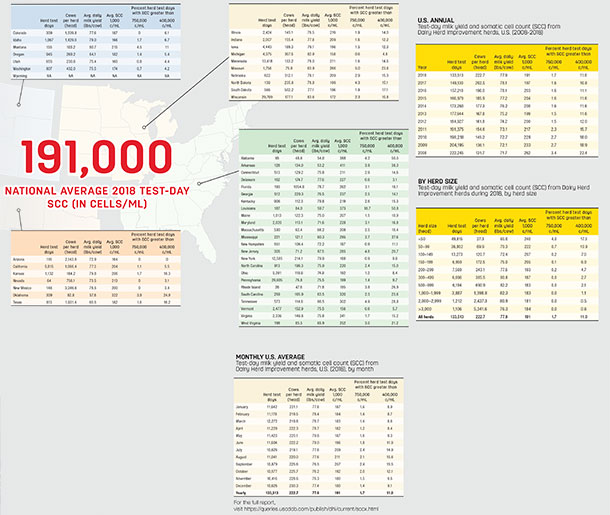Nationally, average 2018 test-day herd SCC was 191,000 cells per milliliter, down 6,000 cells per milliliter for a second consecutive year, according to the Council on Dairy Cattle Breeding and the USDA’s Animal Improvement Programs Laboratory.
Test-day data from all herds enrolled in DHI somatic cell testing during 2018 (98.7 percent of all DHI herds and 97 percent of DHI cows) were examined to document the status of national milk quality. All test-day data within herds on any DHI test plan (including owner-sampler recording) were included.
Individual state data
These tables include individual state data for herd test days, average number of cows per herd, average daily milk yield and average SCC on test day. It also breaks out two categories of SCC levels: the percent of days over 750,000 cells per milliliter, the current federal limit for bulk tank SCC for Grade A producers; and the percent of test days over 400,000 cells per milliliter, the current maximum level for milk headed to European Union and some other export markets. (A few states have lower SCC limits compared to federal requirements.)
Click here or on the image above to view it at full size in a new window.
Herd test days higher than the federal limit may overestimate the percentage of herds shipping milk exceeding that limit because milk from cows treated for mastitis is excluded from the bulk tank, even though it is included in DHI test data.
Thirteen states’ average annual SCC was less than the national average, led by Vermont, Michigan, Utah, Arizona and Idaho – all at less than 170,000 cells per milliliter. Other major dairy states among the nation’s leaders for annual average SCC were Wisconsin, Washington, Oregon, Texas, South Dakota, Colorado and New York.
In contrast, Tennessee, South Carolina, Oklahoma, Louisiana and Alabama averaged more than 300,000 cells per milliliter, with the average in Arkansas above 400,000 cells per milliliter.
State improvement
Thirteen states improved annual average SCC by 10,000 cells per milliliter or more in 2018, led by South Dakota and Georgia, which improved 34,000 and 32,000 cells per milliliter from the year before, respectively. Others with improvements of 22,000 to 28,000 cells per milliliter were Tennessee, Arizona, Louisiana, Washington and Minnesota.
In contrast, average annual SCC rose 10,000 cells per milliliter or more in 14 states. Topping that list were Nevada, Rhode Island, Arkansas and Florida.
Although climatic conditions (temperature and humidity) contributed to regional SCC levels, differences between adjacent states were substantial, suggesting herd size and mastitis-control practices are impacting state differences as well, according to the report’s authors.
Herd size improvement
Herds of 1,000 to 1,999 cows or more showed the most SCC improvement from 2017 (-11,000 cells per milliliter). Herds of 300 to 499 cows, 500 to 999 cows and 2,000 to 2,999 cows each lowered average SCC by 7,000 cells per milliliter. The average annual SCC increased for all herd categories of 199 cows or fewer.
The increase in cows per herd was the largest on record, from 202.5 in 2017 to 222.7 in 2018. Test-day milk yield remained unchanged at 78 pounds.
Monthly improvement
While the annual average improved 6,000 cells per milliliter, January-April had the most improvement (-11,000 to -12,000 cells per milliliter) compared to the same months a year earlier. U.S. average SCC increased 6,000 cells per milliliter in September. The highest quality milk, based on SCC, continues to be produced in November and December. ![]()
To see the full report, visit Somatic cell counts of milk form dairy herd improvement herds during 2018.

-
Dave Natzke
- Editor
- Progressive Dairyman
- Email Dave Natzke







